
Fort Union National Monument is a unit of the National Park Service of the United States, and is located north of Watrous in Mora County, New Mexico. The national monument was founded on June 28, 1954.

The Ávila Adobe, built in 1818 by Francisco Ávila, is the oldest standing residence in the city of Los Angeles, California. Avila Adobe is located in the paseo of historic Olvera Street, a part of the Los Angeles Plaza Historic District, a California State Historic Park. The building itself is registered as California Historical Landmark #145, while the entire historic district is both listed on the National Register of Historic Places and as a Los Angeles Historic-Cultural Monument.

San Felipe de Neri Church is a historic Catholic church located on the north side of Old Town Plaza in Albuquerque, New Mexico. Built in 1793, it is one of the oldest surviving buildings in the city and the only building in Old Town proven to date to the Spanish colonial period. The church is listed on the New Mexico State Register of Cultural Properties and the National Register of Historic Places and has remained in continuous use for over 200 years.

Rancho Petaluma Adobe is a historic ranch house in Sonoma County, California. It was built from adobe bricks in 1836 by order of Mariano Guadalupe Vallejo. It was the largest privately owned adobe structure built in California and is the largest example of the Monterey Colonial style of architecture in the United States. A section of the former ranch has been preserved by the Petaluma Adobe State Historic Park and it is both a California Historic Landmark and a National Historic Landmark. The Rancho Petaluma Adobe State Historic Park is located on Adobe Road on the east side of the present-day town of Petaluma, California.
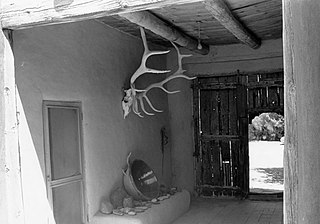
The Georgia O'Keeffe Home and Studio is a historic house museum in Abiquiú, New Mexico. From 1943 until her death, it was the principal residence and studio of artist Georgia O'Keeffe (1887–1986). It is now part of the Georgia O'Keeffe Museum, which has sites in Santa Fe and Abiquiú. Public tours are available March–November, with advance tickets required. The Home and Studio became a National Historic Landmark in 1998, as one of the most important artistic sites in the southwestern United States.
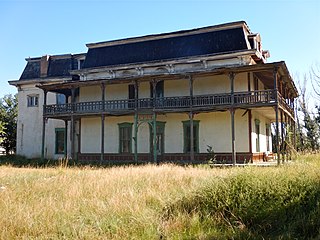
Mills House is a house in Springer, New Mexico, in Colfax County, New Mexico, that was built in 1877. It was listed on the U.S. National Register of Historic Places in 1970. The locals have dubbed it the "Clegg Mansion”, after Luke and Myrtle Clegg who owned and lived in the house for several decades beginning in about 1915.

Seton Village is a National Historic Landmark District in a rural residential area south of Santa Fe in Santa Fe County, New Mexico, United States. It encompasses a residential settlement and educational facility established in 1930 by Ernest Thompson Seton (1860-1946), an educator and conservationist best known as a founder of the Boy Scouts of America. The district includes the remains of Seton's 32-room home and other residential and educational buildings constructed mostly between 1930 and 1945. It was declared a National Historic Landmark in 1965.
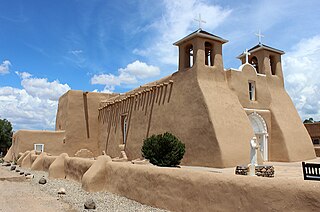
San Francisco de Asís Mission Church is a historic and architecturally significant building on the main plaza of Ranchos de Taos, New Mexico. Originally the center of a small Mexican and Indian 18th Century agricultural community. Built between 1772 and 1816 replacing an earlier church in that location. New Mexico was then part of the Vice-Royalty of New Spain. It is a fine example of a New Mexico Spanish Colonial Church, and is a popular subject for artists. It was designated a National Historic Landmark in 1970. It is a parish church of the Roman Catholic Archdiocese of Santa Fe.
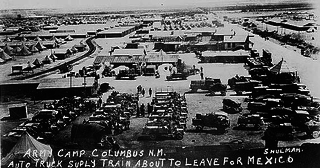
The Village of Columbus and Camp Furlong is a National Historic Landmark District commemorating the 1916 raid by Pancho Villa on the town of Columbus, New Mexico, and the American military response to that raid, the "Punitive Expedition" led by General John J. Pershing. The raid and its response, set during World War I, the Mexican Revolution, and an accompanying low-level Border War, played a significant role in diplomacy and military preparedness for eventual American entry in the World War. The district encompasses buildings which survived the raid, and military facilities used in the American response. The landmark designation was made in 1975.

The Raymond Carr House is a Colonial Revival style house located in Kingman, Arizona. The house is listed on the National Register of Historic Places. It was evaluated for National Register listing as part of a 1985 study of 63 historic resources in Kingman that led to this and many others being listed.

The Phillips Mansion is a Second Empire style historic house in Pomona, Los Angeles County, California. It was built in 1875 by Louis Phillips, who by the 1890s had become the wealthiest man in Los Angeles County. Situated along the Butterfield Stage route, the Phillips Mansion became a center of community activity in the Pomona and Spadra area. It was added to the National Register of Historic Places in 1974, making it among the first 25 sites in Los Angeles County to be so designated.

Boggsville is a former settlement in Bent County, Colorado, USA near the Purgatoire River about 3 miles (4.8 km) above the Purgatoire's confluence with the Arkansas River. It was established in 1866. The surviving structures are among the earliest examples of Territorial architecture in Colorado. Boggsville was the last home of frontiersman Kit Carson before his death in 1868 at Fort Lyon. The U.S. Post Office at Las Animas now serves Boggsville postal addresses.

The Lea Theater, an Art Deco theater in Lovington, New Mexico, was built in 1948. It was listed on the National Register of Historic Places in 2007. Renovations to the historic theater began on January 27, 2020 with updates to the Lobby and Concession area.
Pyburn House, at 203 Fourth Street in Lovington, New Mexico, is an unusual building which was built during 1935–1937. It has also been known as Pyburn Apartments and as the Cornerstone Inn. It was listed on the National Register of Historic Places in 1995.
The Lovington Fire Department Building, also known as the Lovington Fire Station, is a fire station in Lovington, New Mexico which was built in 1941. It was listed on the National Register of Historic Places in 2008.
William Redding House is a historic house in Mimbres, New Mexico. It was built with adobe in 1893 for William Redding, a farmer. The house is "one of four unaltered historic buildings" in Mimbres. It was designed in the Vernacular New Mexico architectural style. It has been listed on the National Register of Historic Places since May 16, 1988.
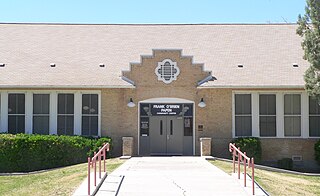
The Mesilla Park Elementary School, in Las Cruces, New Mexico, was listed on the National Register of Historic Places in 2015.

The Hooker Town House is an example of early adobe Queen Anne style residence. Located in Willcox, Arizona, it was listed on the National Register of Historic Places in 1987.
















